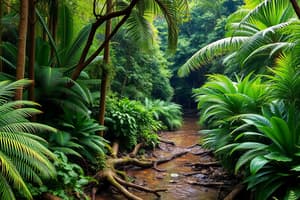Podcast
Questions and Answers
Why are tropical rainforests, coral reefs, and mangrove swamps considered the interconnected foundation of our planet's biodiversity and ecosystem services?
Why are tropical rainforests, coral reefs, and mangrove swamps considered the interconnected foundation of our planet's biodiversity and ecosystem services?
- Due to their aesthetic appeal and recreational value to humans
- Because they have the highest population density of any ecosystems on Earth
- Due to their role in regulating climate and providing essential resources for sustaining life (correct)
- Because they are the only ecosystems that house a significant number of plant species
What is one of the ways in which coral reefs contribute to human well-being among the listed options?
What is one of the ways in which coral reefs contribute to human well-being among the listed options?
- Offering a habitat for desert-dwelling species
- Providing food, livelihoods, and coastal protection (correct)
- Acting as a source of fresh water for nearby communities
- Serving as a major tourist attraction
Why is it crucial for sustainable fishing practices to be implemented in coral reefs and mangrove forests?
Why is it crucial for sustainable fishing practices to be implemented in coral reefs and mangrove forests?
- To attract more migratory bird species to the region
- To ensure the survival of these ecosystems and maintain biodiversity (correct)
- To boost tourism in these areas
- To increase the economic value of the fishing industry
Why is it important to carefully manage the harvesting of timber from tropical rainforests?
Why is it important to carefully manage the harvesting of timber from tropical rainforests?
What is one primary function of mangroves in protecting coastal areas against natural disasters?
What is one primary function of mangroves in protecting coastal areas against natural disasters?
What is the primary role of local communities in sustainable resource management?
What is the primary role of local communities in sustainable resource management?
How do human activities like deforestation impact biodiversity conservation?
How do human activities like deforestation impact biodiversity conservation?
What is the significance of tropical rainforests, coral reefs, and mangrove swamps in climate change mitigation?
What is the significance of tropical rainforests, coral reefs, and mangrove swamps in climate change mitigation?
What is the main threat posed by overfishing and destructive fishing practices?
What is the main threat posed by overfishing and destructive fishing practices?
How can local communities contribute to climate change mitigation efforts?
How can local communities contribute to climate change mitigation efforts?
Flashcards are hidden until you start studying
Study Notes
Preserving the Vital Web of Life: Protecting Tropical Rainforests, Coral Reefs, and Mangrove Swamps
These three ecosystems – tropical rainforests, coral reefs, and mangrove swamps – form the interconnected foundation of our planet's biodiversity and ecosystem services. They serve as homes for an incredible variety of species, regulate climate, and provide essential resources to sustain life. In this article, we'll explore the significance of these ecosystems and the efforts to protect them from human impacts and climate change.
Ecosystem Services
Ecosystem services are the benefits humans receive from ecosystems, such as food production, clean water, recreational opportunities, and climate regulation. Tropical rainforests, coral reefs, and mangrove swamps deliver a plethora of these services. Tropical rainforests harbor a staggering 50% of the world's plant and animal species, and they are a critical source of medicines and indigenous knowledge. Coral reefs provide food, livelihoods, and coastal protection to millions of people, while mangroves offer a natural defense against storm surges and erosion.
Sustainable Resource Management
Tropical rainforests, coral reefs, and mangrove swamps are vital for maintaining the sustainable use of natural resources. Harvesting timber from rainforests, for example, must be carefully balanced to ensure the survival of the ecosystem. The same applies to sustainable fishing practices in coral reefs and mangrove forests. Efforts to ensure sustainable resource management include working with local communities to promote ecotourism, supporting agroforestry systems, and improving fisheries management.
Biodiversity Conservation
The loss of tropical rainforests, coral reefs, and mangrove swamps leads to a reduction in biodiversity, which, in turn, affects the stability and resilience of ecosystems. To conserve biodiversity in these systems, governments, non-governmental organizations, and local communities are working together to create protected areas and to promote sustainable land and sea use practices.
Human Impact
Human activities, such as deforestation, mining, and overfishing, pose a significant threat to tropical rainforests, coral reefs, and mangrove swamps. Deforestation, for example, accounts for about 10-15% of global greenhouse gas emissions, while overfishing and destructive fishing practices threaten the survival of coral reefs. To mitigate these impacts, efforts are underway to promote sustainable land use practices, reduce deforestation, and strengthen fisheries management.
Climate Change Mitigation
Tropical rainforests, coral reefs, and mangrove swamps play a crucial role in mitigating climate change by absorbing and storing carbon dioxide (CO2). Tropical forests, for instance, store an estimated 250 gigatons of carbon, which is equivalent to approximately 20 years' worth of global human greenhouse gas emissions. Coral reefs and mangroves also play a significant role in carbon sequestration, providing a natural buffer against the impacts of climate change.
Conclusion
Tropical rainforests, coral reefs, and mangrove swamps constitute the planet's most diverse and valuable ecosystems. As a global community, we must prioritize their protection to ensure the continuation of their ecosystem services, biodiversity conservation, and climate change mitigation efforts. By working together to reduce deforestation, promote sustainable land and sea use practices, and strengthen fisheries management, we can safeguard these vital ecosystems – for the benefit of present and future generations.
Studying That Suits You
Use AI to generate personalized quizzes and flashcards to suit your learning preferences.




